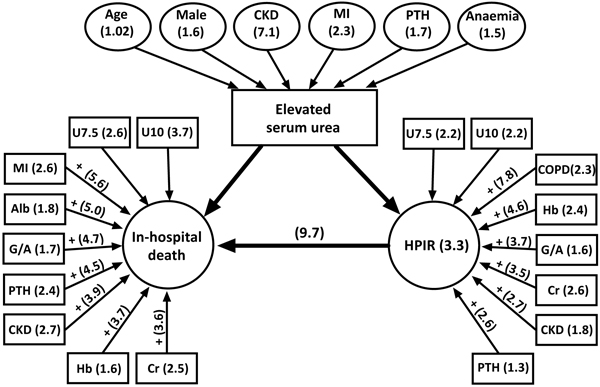Fig. (2)
Integrative schematic illustration of the prognostic impact of elevated urea at admission alone and in combination with other factors for predicting poor in-hospital outcome in older patients with HF.
Conditions independently associated with elevated urea at admission are shown in ovals. Square boxes indicate on admission factors (adjusted for age and gender) influencing the specific outcome. Odds ratios for each parameter are shown in brackets; + above the arrow indicates combined effect of two parameters on the outcome.
Abbreviations: CKD, chronic kidney disease; MI, history of myocardial infarction; COPD, chronic obstructive pulmonary disease; HPIR, high postoperative inflammatory response; PTH, hyperparathyroidism (>6.8pmol/L); Alb, serum albumin<33g/L; G/A, gamma-glutamyl transferase/alanine aminotransferase ratio (GGT/ALT); Hb, anaemia (haemoglobin<110g/L); Cr, creatinine >90µmol/L
Notes: CKD, history of MI, hyperparathyroidism, anaemia, advanced age and male gender are independent and significant factors associated with elevated urea at admission, which is a strong indicator of both in-hospital death and developing a HPIR.
Increased urea at admission combined with any other risk factor has an additive prognostic effect. Elevated urea predisposes to a HPIR, which carries a high risk of a fatal outcome by itself, and in patients exposed to both conditions a synergistic effect on mortality occurs.


